
Related
Topics
Guests
- Ole Solvangsenior emergency researcher for Human Rights Watch. He recently returned from Ukraine and is the lead author of the new HRW report, “Ukraine: Rising Civilian Toll in Luhansk.”
- Jack Matlockserved as U.S. ambassador to the Soviet Union from 1987 to 1991. He is the author of several books, including Superpower Illusions: How Myths and False Ideologies Led America Astray—And How to Return to Reality and Reagan and Gorbachev: How the Cold War Ended.
We continue our coverage of Ukraine by looking at the humanitarian crisis on the ground. According to the United Nations, more than one million people have been displaced by the fighting. Some 800,000 Ukrainians have fled to Russia, another 260,000 are displaced inside Ukraine. We speak to Ole Solvang, senior emergency researcher for Human Rights Watch. He returned recently returned from eastern Ukraine and is the lead author of the new HRW report, “Ukraine: Rising Civilian Toll in Luhansk.” The report details how both Ukrainian forces and Russian-backed rebels are contributing to the rising death toll in the besieged city where many residents have not had electricity, gas and running water for weeks. Food and fuel are running low.
Transcript
AMY GOODMAN: We continue our coverage of Ukraine by looking at the humanitarian crisis on the ground. According to the United Nations, more than a million people have been displaced by the fighting. Over 800,000 Ukrainians have fled to Russia; another 260,000 are displaced inside Ukraine.
Joining us from Paris, France, is Ole Solvang, a senior emergency researcher for Human Rights Watch. He just returned recently from eastern Ukraine, is the lead author of the new report, “Ukraine: Rising Civilian Toll in Luhansk.” The report details how both Ukrainian forces and Russian-backed rebels are contributing to the rising death toll in the besieged city, where many residents have not had electricity, gas and running water for weeks. Also still with us, Jack Matlock, who served as U.S. ambassador to the former Soviet Union from ’87 to ’91.
Ole Solvang, talk about the situation on the ground right now, and describe the map of Ukraine for us, where the crisis is.
OLE SOLVANG: Well, Luhansk is a city that has been under siege by the Ukrainian army for several weeks now. It’s held by the separatist forces. So, it is a place that’s difficult to get into. All communications are cut. And so, we know less about what’s going on in Luhansk than in other places, and that’s part of the reason why we felt that it was so important to get there.
An interesting thing was that when you arrived in Luhansk in the afternoon, it was—it seemed completely empty. It seemed like a ghost town. There was nobody in the street. But then, in the morning, very early on, from around 6:00 in the morning, you would see dozens, hundreds of people lining up in the street at water and food distribution points. The city has not had running water—most of the residents have not had running water for weeks and no electricity. And so, the humanitarian situation there is quite difficult. They’re running out of food, they’re running out of fuel.
But perhaps the most—the biggest challenge for people living there, as they told us, was the ongoing bombardment, the ongoing shelling. Nearly daily, there are strikes in the city, including in the city center, but particularly on the outskirt. And we saw that ourselves. And we looked into these—some of these strikes, and they appear to be indiscriminate. They are killing and injuring civilians. A morgue doctor there said that about 300 civilians had died in Luhansk city alone since the military operations started there in May.
AMY GOODMAN: And if you could describe for us just where Luhansk and Donetsk is in relation to Russia, draw a word map for us.
OLE SOLVANG: Sure. So, both Donetsk and Luhansk are in eastern Ukraine. Donetsk is the bigger of the cities. Normally, it has about one million inhabitants. Luhansk is about half that size. But Luhansk is much closer to the Russian border. It’s fairly close there. And right now, when I was there, at least, the Ukrainian army had surrounded the city Luhansk, and they were fighting, very intensive fighting, on the outskirts. Now, in the recent—as we heard on the news in recent days, the separatists have launched counteroffensives and taken back the airport, for example. But the situation there is still very difficult.
AMY GOODMAN: Can you talk about the number of deaths and who is responsible for these deaths in the area?
OLE SOLVANG: Well, it’s difficult to establish with certainty how many civilians have suffered, how many civilians have been killed. And it’s even more difficult to establish how many soldiers and fighter separatists have been killed, but our focus is on the civilians. So, in Luhansk, the first thing we did was go to the morgue in Luhansk city, and the head of the morgue told us that they had registered more than 300 civilians who had been killed. And he said that all of them had been killed—almost all of them, there were a few exceptions, had been killed by shrapnel injuries from artillery and rocket shelling. The morgue also was having difficulties operating without electricity. When we got there, there were 17 bodies lying outside on the lawn, and the morgue was hoping to get generators starting again to get the fridges starting again.
Who is responsible? In many cases, it’s difficult to determine with certainty. I think there is, logically, if you look at the situation—the separatists are holding the city, the Ukrainian army is trying to retake the city, so, logically, I think that there is an assumption that rockets, artillery shells that fall within the city come from the Ukrainian army. The Ukrainian government is claiming that these are rebels firing into their own areas. There might be cases of that, but in most of the cases we looked at, the evidence pointed to the Ukrainian army. For example, we know that the central market in Luhansk was hit by a shell that burned down half of the market and killed four people. Right next to the central market is the headquarters of the separatists, which is a strong indication that that might have been the target of the Ukrainian army, and in this particular attack, they just missed and hit the central market instead.
AMY GOODMAN: And the vast numbers of refugees, internal and those leaving Ukraine, Ole?
OLE SOLVANG: Well, there are vast numbers, and what we’re seeing, more and more are coming out. And, you know, we’ve spoken to many of them. They do cite the difficult humanitarian situation in Luhansk, in particular. But most of them said that the determining factor for them, the trigger point, if you will, was the increased shelling in their neighborhoods. Many of the people we spoke to could cite several examples in their neighborhoods or in their streets where shells had fallen, hit houses, burned down houses or killed civilians. So this is really, you know, one of the main driving factors that are driving people out of these cities and into Ukraine or into Russia.
AMY GOODMAN: Ambassador Matlock, what do you think should be the approach? President Obama will be giving a major speech today where he is, in Estonia. The NATO summit is taking place in Wales. What do you think should happen? What do you think would solve this crisis in Ukraine?
JACK MATLOCK: Well, I hope that the diplomatic efforts, the quiet diplomatic efforts, are going to start bearing some fruit. It does seem to me that a lot of the public rhetoric doesn’t help, and the accusations back and forth, no matter how accurate. I think President Obama recently has been much more restrained than some of the other spokespersons. So I don’t want to be focusing entirely on that, except that we have to understand the Russian attitude, which is that what they’re doing is defending from Western interference, therefore anything that seems to challenge that simply stimulates, you might say, the opposite reaction from Russia. It is a tragic situation, particularly for the people directly involved. No question about that. And it’s only going to be solved, I think, by negotiations where both the Russians and the Ukrainian government is reasonable in what they demand of the other and what they agree upon. There is going to have to be a settlement there between the two. That’s where it has to be. And I think outsiders need to be a little careful that they don’t seem to stimulate one side or the other to be more rigid than they should be. But I can’t predict what’s going to happen.
AMY GOODMAN: What do you think Russia wants, Ambassador Matlock?
JACK MATLOCK: But if it is solved, it will be solved by a quiet compromise between Russia and the Ukrainian leaders.
AMY GOODMAN: What does Russia want, Ambassador Matlock?
JACK MATLOCK: I’m sorry?
AMY GOODMAN: What does Russia want?
JACK MATLOCK: What does Russia want?
AMY GOODMAN: Yes.
JACK MATLOCK: They want a Ukraine that is not a threat to them, a friendly Ukraine. That’s what they want. And the people who seized power in Kiev in February are openly and vehemently anti-Russian. Now, they may have a good reason for that, but that view is not shared by the people in the east, who don’t necessarily want to be part of Russia, but they also don’t want a country which deprives them of free contact with Russia. And this is, in essence, a family fight. That’s something we have to understand, we outsiders. Ukraine is a very complex country, which has been put together rather artificially, to be frank, and without any real consultation of the Ukrainians as to where the borders were and so on. And to treat it as if it’s some primordial unified state is simply incorrect. So, you know, Ukraine is basically a house which since independence has been divided against itself. That is the basic problem. And outsiders taking one side or the other doesn’t help. It is inevitable that Russia is going to take a side, because it is part of their backyard. Many Russians would say part of their own heritage. So, we’re dealing with highly emotional issues, when we outsiders get involved. And when we start talking about military action and military alliances, we cause very irrational and very damaging reactions.
AMY GOODMAN: Ambassador Jack Matlock, I want to thank you for being with us, a former ambassador to the former Soviet Union from ’87 to ’91.
JACK MATLOCK: Glad to be with you. Thank you.
AMY GOODMAN: Great to have you with us. Among the books that he has written, Autopsy of an Empire: The American Ambassador’s Account of the Collapse of the Soviet Union. Ole Solvang, while we still have you on satellite in Paris, France, I wanted to quickly switch gears to talk about what you have been working on for the past three to four years, though you haven’t been back recently because of the danger, and that’s Syria. If you could summarize for us what you understand is happening on the ground in Syria, what Human Rights Watch has found?
OLE SOLVANG: Well, what we’re finding, unfortunately, is that violations by the Syrian government continues, that indiscriminate shelling continues. We have received a lot of information about continued torture and deaths in custody. And, of course, recently, we have been focused very much on the threat that the Islamic State is posting and the violations that they’re committed. Just today, we released new findings about mass executions. We have now documented five sites in Tikrit with an estimated number of bodies anywhere from 500 up to almost 800 bodies in these mass graves who have been executed by—apparently executed by the Islamic State. So these are very, very serious violations.
I think what is also important to keep in mind, though, as the world is very much focused on these violations, is that we should not allow these—we should not allow these violations to make us turn a blind eye to the violations committed by the Syrian government and by the Iraqi government and Shia militias. And there is an argument to be made that violations by these two governments contributed to the rise of Islamic State by antagonizing the Sunni population. So what Human Rights Watch is calling for is really to be principled in terms of condemning all human rights violations, no matter who is doing them, even in the face of the very horrific violations that we’re seeing from the Islamic State.
AMY GOODMAN: Ole Solvang, I want to thank you for being with us, senior emergency researcher for Human Rights Watch, returned recently from Ukraine, is the lead author of the report on Ukraine called “Ukraine: Rising Civilian Toll in Luhansk,” who also has spent the last years looking at the situation in Syria. This is Democracy Now! When we come back, we stay in Iraq and Syria and on the Islamic State. We’ll be joined by an Iraqi journalist, as well as a spokesperson for the Committee to Protect Journalists. Stay with us.

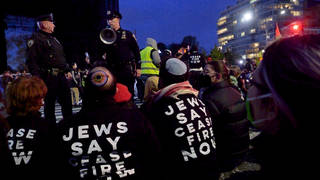
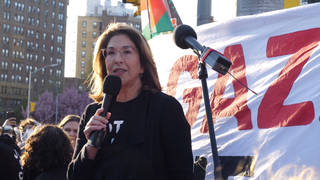
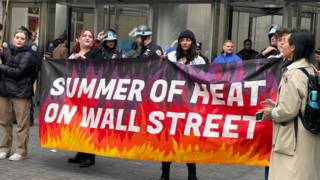
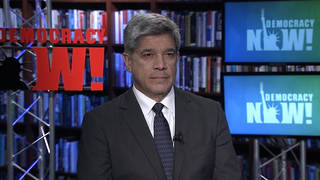





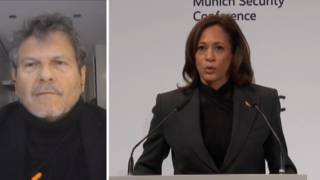
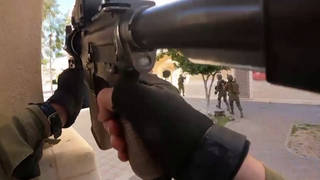
Media Options